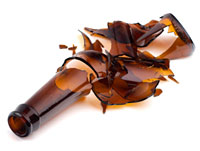Why is the Oregon bottle bill, once a shining environmental breakthrough, failing?
As a wise person named Lee Barrett noted here:
It’s the distributors than own the reverse vending machines. They are the ones that start the 5-cent deposit. The more disgusted you get with the process of returning the cans and bottles the more nickels they get to keep. They’re not happy until you’re not happy.
He/she’s got other good things to say too, but it’s his/her major point that every environmentalist should especially take heed of: You have to design systems so that it pays better to do the right thing than the wrong one.

That’s the original premise of the bottle bill (make them pay a deposit so that it pays better to return empties than to discard them), but it overlooked that there are other ways to raise the price to restore the throwaway incentive.
In Oregon, that means replacing 16-year-olds doing bottle returns with machines outside the store, in the rain, that accept one can or bottle at a time only, and then only about half the time, tops. (The rest of the time, the machines simply don’t work at all.)
When you consider this point, the proposed expansion of the bottle bill (adding water bottles, raising the deposit to 10 cents) looks like a recipe for disaster: It will now be twice as profitable per bottle (and for a lot more bottles) for grocers to make bottle returns a hellishly unpleasant experience in terms of time and convenience. Not the right approach, in other words. And a good case study for all environmental policy issues.


